Stan C. Smith's Blog, page 5
October 18, 2024
Our Panama Adventure - Toucans
Now that I've shared the monkeys we saw, let's consider one of my favorite birds, the TOUCAN. Actually, we saw three types of toucans. The first photo is a KEEL-BILLED TOUCAN, the second is a BLUE-THROATED TOUCANET, and the third is a COLLARED ARACARI.
In my opinion, toucans are the cartoon characters of the bird world. My question is: What's up with that huge, beautiful bill (beak)? Their bill can be four times the size of their head, and as long as their body.
Seriously, isn't that kind of extreme?
Well, as you can probably imagine, a toucan's bill is, by necessity, amazingly lightweight. They are also very strong—have you ever seen a toucan with a broken beak? Neither have I.
As it turns out, these beaks serve a variety of functions. They help the bird reach fruits at the ends of narrow branches and in crevices. They can be used as a weapon against predators and against each other. The serrated edges can be used like a saw for tearing up food. They can be used for cracking open seeds. The bright colors are almost certainly used for attracting mates, and for identifying members of their own species.
Perhaps one of the most intriguing functions of a toucan's bill is thermoregulation. Tropical forests are hot, and creatures living there have evolved elaborate ways to keep their bodies cool. I've never touched a live toucan's bill, but biologists say the bills are very warm to the touch. Why? Because the bills have an elaborate system of blood vessels near the surface. Scientists have actually tested this using infrared sensors. They looked at the amount of heat given off by the toucan's beak when it is resting. Then they chased the toucan around in its cage for ten minutes (to stimulate exertion), and measured the heat given off by the beak again. After the exertion, the beak was much warmer. Which means the bird was releasing more heat to keep its body at the optimal temperature.
Who says something can't be pretty and functional at the same time?

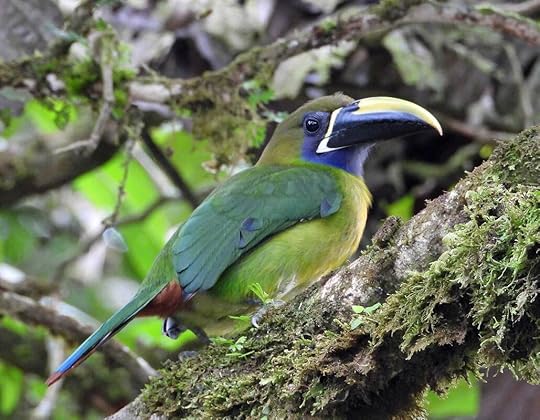

Photo credits:
Toucans - Stan C. Smith
In my opinion, toucans are the cartoon characters of the bird world. My question is: What's up with that huge, beautiful bill (beak)? Their bill can be four times the size of their head, and as long as their body.
Seriously, isn't that kind of extreme?
Well, as you can probably imagine, a toucan's bill is, by necessity, amazingly lightweight. They are also very strong—have you ever seen a toucan with a broken beak? Neither have I.
As it turns out, these beaks serve a variety of functions. They help the bird reach fruits at the ends of narrow branches and in crevices. They can be used as a weapon against predators and against each other. The serrated edges can be used like a saw for tearing up food. They can be used for cracking open seeds. The bright colors are almost certainly used for attracting mates, and for identifying members of their own species.
Perhaps one of the most intriguing functions of a toucan's bill is thermoregulation. Tropical forests are hot, and creatures living there have evolved elaborate ways to keep their bodies cool. I've never touched a live toucan's bill, but biologists say the bills are very warm to the touch. Why? Because the bills have an elaborate system of blood vessels near the surface. Scientists have actually tested this using infrared sensors. They looked at the amount of heat given off by the toucan's beak when it is resting. Then they chased the toucan around in its cage for ten minutes (to stimulate exertion), and measured the heat given off by the beak again. After the exertion, the beak was much warmer. Which means the bird was releasing more heat to keep its body at the optimal temperature.
Who says something can't be pretty and functional at the same time?



Photo credits:
Toucans - Stan C. Smith
Published on October 18, 2024 05:05
October 16, 2024
Our Panama Adventure - More Monkey Business
Trish and I saw four monkey species on Panama trip. In my last post, I showed photos of Geoffroy's Tamarin. And here are the other three.
The first two photos are MANTLED HOWLER MONKEYS. These are not the same species we usually see in Belize. These monkeys can be heard at least a half mile away, and they often howl in the early mornings and evenings.
The next one is the WHITE-FACED CAPUCHIN. This one seemed to have a perpetually grouchy face.
Finally, the last photo is a WESTERN NIGHT MONKEY. These are nocturnal, which makes them difficult to photograph. I took this photo while our guide shone a spotlight on it.


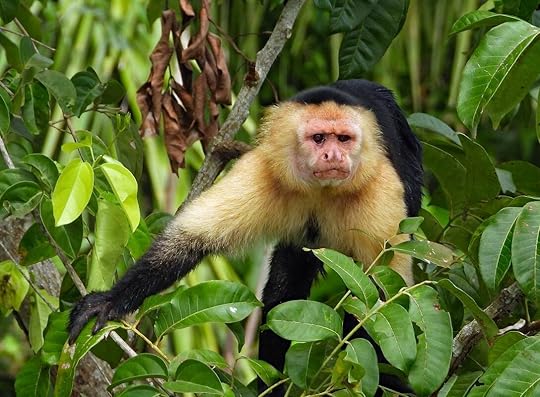
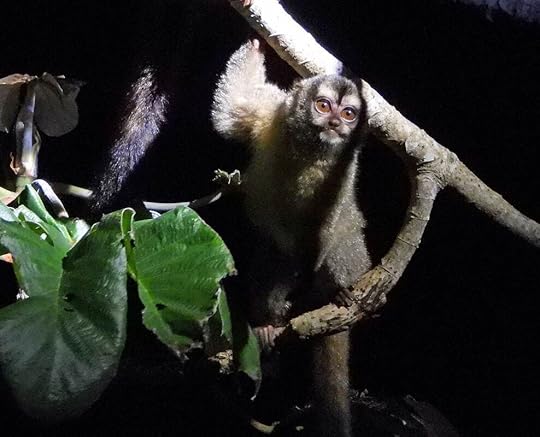
Photo credits:
Monkeys - Stan C. Smith
The first two photos are MANTLED HOWLER MONKEYS. These are not the same species we usually see in Belize. These monkeys can be heard at least a half mile away, and they often howl in the early mornings and evenings.
The next one is the WHITE-FACED CAPUCHIN. This one seemed to have a perpetually grouchy face.
Finally, the last photo is a WESTERN NIGHT MONKEY. These are nocturnal, which makes them difficult to photograph. I took this photo while our guide shone a spotlight on it.




Photo credits:
Monkeys - Stan C. Smith
Published on October 16, 2024 11:17
Our Panama Adventure - Geoffroy's Tamarins
Trish and I recently returned from an awesome tropical forest adventure in Panama. We stayed at Canopy Tower and Canopy Lodge, with a focus on Tropical Biodiversity. I'll be sharing numerous photos and stories in the coming days.
Let's start with monkeys! We saw four monkey species, including Panama's smallest monkey, called Geoffroy's Tamarin, about the size of a squirrel. These tiny monkeys live in social groups, so if you see one, you'll likely see more. They spend much of the day foraging for fruits, flowers, and insects. I photographed these tamarins from the observation deck atop the Canopy Tower.
Tamarins were sporting the mohawk hairstyle long before it was cool.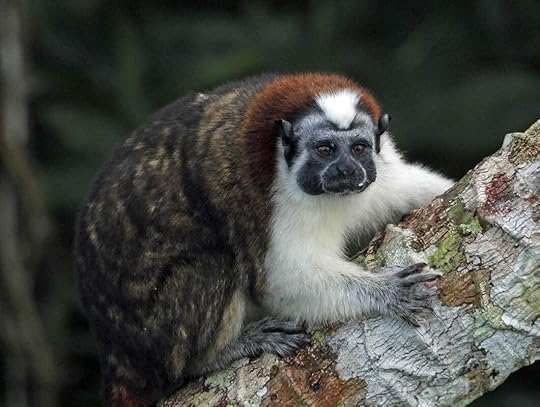


Photo credits:
Tamarin photos - Stan C. Smith
Let's start with monkeys! We saw four monkey species, including Panama's smallest monkey, called Geoffroy's Tamarin, about the size of a squirrel. These tiny monkeys live in social groups, so if you see one, you'll likely see more. They spend much of the day foraging for fruits, flowers, and insects. I photographed these tamarins from the observation deck atop the Canopy Tower.
Tamarins were sporting the mohawk hairstyle long before it was cool.



Photo credits:
Tamarin photos - Stan C. Smith
Published on October 16, 2024 11:13
September 24, 2024
Life's Great Mysteries... Why aren’t people riding zebras the way they ride horses?
I haven’t ridden very many horses, and I’ve never owned a horse. But… if I could ride a domesticated zebra, I might consider becoming a cowboy. In fact, in the second book of my Peregrine Outpost series, a leader of the bad guys rides a zebra, which gives him a certain lofty status among his tribe members. Seriously, how cool would it be to ride a zebra? The only place I wouldn’t ride my zebra would be on the plains of the Serengeti. Because riding one there would be like offering the lions a double-layer snack.
So, why haven’t people domesticated zebras? Humans originated in the land of zebras—it’s not like our ancestors didn’t have plenty of time to make this goal a priority. Zebra-riding seems like a no-brainer, so why didn’t they do it?
As it turns out, plenty of people have tried. In fact, the 2005 movie Racing Stripes, one of those talking-animal movies, is about a zebra that wants to be a racehorse. But even in this movie, the producers had to use a horse (in zebra makeup) for the actual riding and racing scenes. Why?
Horses, donkeys, and zebras all came from a common ancestor that lived millions of years ago in North America and Europe. As you probably know, the ones in North America went extinct about 10,000 years ago (there aren’t really any wild horses in North America today, just feral horses that escaped from herds of domestic horses brought over from Europe). Donkeys and zebras are more closely related to each other than to horses. Horses were domesticated in western Eurasia, and they were first kept as food animals, then eventually people figured out they could ride them. Thusly, they became an important element of the development of human civilization.
Horses, donkeys, and zebras were all preyed upon by large predators, but zebras lived amidst a wide variety of the world’s most impressive predators. To survive, they evolved to be particularly alert, to flee at any sign of danger, and—perhaps most importantly—to fight desperately when captured. I’ve seen videos in which zebras kick pursuing lions, breaking the lions’ jaws (a lion with a broken jaw will soon starve). Also, zebras bite viciously when they feel threatened. In 2013, a zebra at the National Zoo in Washington DC attacked and repeatedly bit a zoo keeper, sending the keeper to the hospital for surgery. Zebras also have a strong “ducking reflex” to escape attack, making it difficult to lasso them.
Basically, zebras are just not people friendly. In order for an animal species to be a good candidate for domestication, the animal should be naturally fond of humans, and it helps if the animal has a desire for a comfortable life and is easy to work with and tend. Horses, yes. Zebras, nope.
Okay, remember above when I said I would not ride my theoretical zebra across the Serengeti? I wasn’t kidding. It’s likely that thousands of generations of early humans avoided even trying to domesticate zebras, knowing that zebras were basically lion fodder. This, and the zebra’s belligerent behavior, explain why zebras have never been domesticated, and why I’ll never be a zebra-riding cowboy.
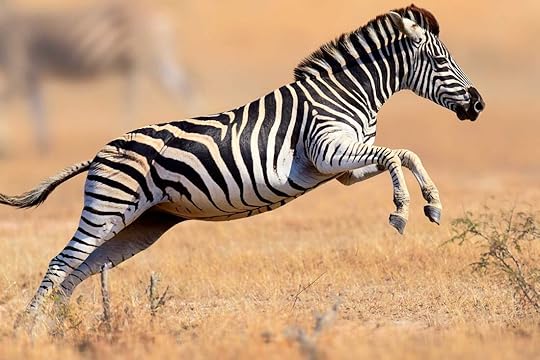
Photo Credits:
- Zebra - DepositPhotos
So, why haven’t people domesticated zebras? Humans originated in the land of zebras—it’s not like our ancestors didn’t have plenty of time to make this goal a priority. Zebra-riding seems like a no-brainer, so why didn’t they do it?
As it turns out, plenty of people have tried. In fact, the 2005 movie Racing Stripes, one of those talking-animal movies, is about a zebra that wants to be a racehorse. But even in this movie, the producers had to use a horse (in zebra makeup) for the actual riding and racing scenes. Why?
Horses, donkeys, and zebras all came from a common ancestor that lived millions of years ago in North America and Europe. As you probably know, the ones in North America went extinct about 10,000 years ago (there aren’t really any wild horses in North America today, just feral horses that escaped from herds of domestic horses brought over from Europe). Donkeys and zebras are more closely related to each other than to horses. Horses were domesticated in western Eurasia, and they were first kept as food animals, then eventually people figured out they could ride them. Thusly, they became an important element of the development of human civilization.
Horses, donkeys, and zebras were all preyed upon by large predators, but zebras lived amidst a wide variety of the world’s most impressive predators. To survive, they evolved to be particularly alert, to flee at any sign of danger, and—perhaps most importantly—to fight desperately when captured. I’ve seen videos in which zebras kick pursuing lions, breaking the lions’ jaws (a lion with a broken jaw will soon starve). Also, zebras bite viciously when they feel threatened. In 2013, a zebra at the National Zoo in Washington DC attacked and repeatedly bit a zoo keeper, sending the keeper to the hospital for surgery. Zebras also have a strong “ducking reflex” to escape attack, making it difficult to lasso them.
Basically, zebras are just not people friendly. In order for an animal species to be a good candidate for domestication, the animal should be naturally fond of humans, and it helps if the animal has a desire for a comfortable life and is easy to work with and tend. Horses, yes. Zebras, nope.
Okay, remember above when I said I would not ride my theoretical zebra across the Serengeti? I wasn’t kidding. It’s likely that thousands of generations of early humans avoided even trying to domesticate zebras, knowing that zebras were basically lion fodder. This, and the zebra’s belligerent behavior, explain why zebras have never been domesticated, and why I’ll never be a zebra-riding cowboy.

Photo Credits:
- Zebra - DepositPhotos
Published on September 24, 2024 09:45
September 19, 2024
The Harvest Moon and Lunar Eclipse of September 17, 2024
On Tuesday night, at the designated time (9:35 PM), Trish talked me into going outside to observe the supermoon. I sighed, thinking about how comfortable I already was, but I grabbed my camera and out we went. Glad I did. A bonus was seeing a partial lunar eclipse at the same time. I got some nice photos.
What the heck is a supermoon, anyway? It's another word for harvest moon, which is a full moon when the moon is closer to Earth than usual. Technically, an astronomer would tell you this is when the moon is within 90% of perigee (which is the moon's closest approach to Earth in its orbit). Typically, the distance between Earth and the moon averages about 239,000 miles. On Tuesday night, it was at about 222,000 miles.
The traditional name harvest moon refers to the fact that it usually happens in the early fall, when many crops are almost ready for harvesting.
Okay, so what is a lunar eclipse? This is when the moon enters Earth's shadow. If you think about it, a lunar eclipse can only happen when the moon is full. Why? Because the moon is full only when Earth is directly between the sun and the moon. In other words, when you look up at the moon, the sun has to be directly behind your line of sight in order to fully illuminate the moon as you look at it. If the sun is not directly behind your line of sight, you see only a portion (a sliver) of the moon.
And on Tuesday, we were treated to a harvest moon AND a partial lunar eclipse at the same time. This is why it looks like there is a bite out of the top of the moon in my photo. That's Earth's shadow.

What the heck is a supermoon, anyway? It's another word for harvest moon, which is a full moon when the moon is closer to Earth than usual. Technically, an astronomer would tell you this is when the moon is within 90% of perigee (which is the moon's closest approach to Earth in its orbit). Typically, the distance between Earth and the moon averages about 239,000 miles. On Tuesday night, it was at about 222,000 miles.
The traditional name harvest moon refers to the fact that it usually happens in the early fall, when many crops are almost ready for harvesting.
Okay, so what is a lunar eclipse? This is when the moon enters Earth's shadow. If you think about it, a lunar eclipse can only happen when the moon is full. Why? Because the moon is full only when Earth is directly between the sun and the moon. In other words, when you look up at the moon, the sun has to be directly behind your line of sight in order to fully illuminate the moon as you look at it. If the sun is not directly behind your line of sight, you see only a portion (a sliver) of the moon.
And on Tuesday, we were treated to a harvest moon AND a partial lunar eclipse at the same time. This is why it looks like there is a bite out of the top of the moon in my photo. That's Earth's shadow.

Published on September 19, 2024 09:21
September 11, 2024
Life's Great Mysteries - Are 3D printers a gift from a future civilization?
Yeah, I know 3D printers aren’t from the future, but some kinds of technology make me wonder sometimes. Recently, when visiting our daughter Katie, her husband Michael showed me how his 3D printer works. It was the first time I had actually seen one operate. 3D printers have been around for a while, and I suppose they aren’t as astounding as some of the new AI technologies, or even newer cell phones for that matter. But still… they print anything you can imagine as a three-dimensional object. That’s Star Trek territory, maybe even The Jetsons!
How do they actually work? Well, first you have to have on your computer a digital 3D model of an object. A 3D model includes all the spatial information, such as height, width, and the precise measurements of every portion of the object. Every contour, every surface, every projection, everything. 3D models are actually quite common, as almost all products are modeled in 3D before companies produce them. Also, most animated movies and shows are now just 3D characters, 3D objects, and 3D backgrounds. A 3D model can be made from several photos (or drawings) of something, as long as the photos show all the sides of the object.
Next, you use software to convert your 3D model into an STL (stereolithography) file. This maps the object’s entire surface as a series of triangles.
The STL file is then used by software that creates really thin slices of the model, from the bottom of the object to the top. The 3D printer then lays down a thin layer of material for each of the slices, building the object from the bottom up. Basically, it’s kind of like an inkjet printer, but instead of laying down one thin one-dimensional line of ink at a time to create a 2D image, it lays down a heated layer of resin one 2D slice at a time, piling the slices on top of each other. The resin is heated just before being squirted on top of the previous slice, and it quickly cools, then the printer scans the layer with UV light, which cures it.
I recently watched a video about huge 3D printers that print houses by laying down one thin layer of concrete at a time.
Some of the most impressive 3D printers actually use metal instead of resin, using an electron beam to melt metal powder into each layer. These machines can quickly make things like replacement metal machine parts, surgical implants, and anything else you can think of.
Imagine this futuristic scenario: a large ship is out at sea (or, better yet, out in space) for a long time. It is not feasible to store every possible spare replacement part aboard the ship. The parts would take up too much space. But the 3D files for every imaginable part could be available on a ship computer, along with a 3D printer to print any replacement part that is needed (especially if the faulty part can be used for raw material to make the new part) .
Like I said... this is Star Trek territory.
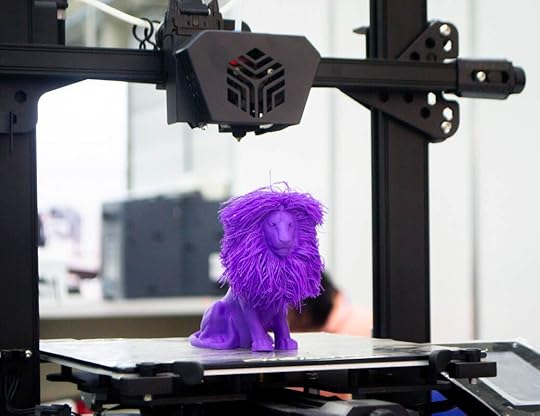
Photo Credits:
- 3D Printer - DepositPhotos
How do they actually work? Well, first you have to have on your computer a digital 3D model of an object. A 3D model includes all the spatial information, such as height, width, and the precise measurements of every portion of the object. Every contour, every surface, every projection, everything. 3D models are actually quite common, as almost all products are modeled in 3D before companies produce them. Also, most animated movies and shows are now just 3D characters, 3D objects, and 3D backgrounds. A 3D model can be made from several photos (or drawings) of something, as long as the photos show all the sides of the object.
Next, you use software to convert your 3D model into an STL (stereolithography) file. This maps the object’s entire surface as a series of triangles.
The STL file is then used by software that creates really thin slices of the model, from the bottom of the object to the top. The 3D printer then lays down a thin layer of material for each of the slices, building the object from the bottom up. Basically, it’s kind of like an inkjet printer, but instead of laying down one thin one-dimensional line of ink at a time to create a 2D image, it lays down a heated layer of resin one 2D slice at a time, piling the slices on top of each other. The resin is heated just before being squirted on top of the previous slice, and it quickly cools, then the printer scans the layer with UV light, which cures it.
I recently watched a video about huge 3D printers that print houses by laying down one thin layer of concrete at a time.
Some of the most impressive 3D printers actually use metal instead of resin, using an electron beam to melt metal powder into each layer. These machines can quickly make things like replacement metal machine parts, surgical implants, and anything else you can think of.
Imagine this futuristic scenario: a large ship is out at sea (or, better yet, out in space) for a long time. It is not feasible to store every possible spare replacement part aboard the ship. The parts would take up too much space. But the 3D files for every imaginable part could be available on a ship computer, along with a 3D printer to print any replacement part that is needed (especially if the faulty part can be used for raw material to make the new part) .
Like I said... this is Star Trek territory.

Photo Credits:
- 3D Printer - DepositPhotos
Published on September 11, 2024 08:00
September 6, 2024
In our neck of the woods... Horseflies
This is the time of the year when giant horseflies are everywhere, looking for a blood meal. Seriously, these puppies are over an inch long, quite large for a fly. The males are nice, docile eaters of pollen and nectar from flowers, but the females are demons from the apocalypse.
You think I'm exaggerating? Then you haven't been chomped by an inch-long female horsefly. It hurts, and here's why: Mosquitoes drill a nice clean hole in your skin, then drink your blood through a straw—not very painful. Horseflies (and the smaller deer flies, for that matter) have mouthparts that act like a pair of serrated knives. They slide these back and forth, making a gash in your skin so they can slurp up the blood that comes out. They have anticoagulants in their saliva, which keeps the blood flowing.
On humans, though, the knife-sawing business is so painful that we usually curse, then swat at the fly while doing an awkward horsefly dance. Therefore, the fly doesn't have a chance to get much of a blood meal, so it continues buzzing around, hoping for another opportunity for a knife attack.
Now here's the real reason why I'm talking about horseflies today. Trish and I have noticed, as we drive our vehicles down the one-mile gravel road from our house to the nearest paved road, numerous horseflies attack our cars, chasing us and slamming into our windows and hoods, even when we are going twenty miles per hour. We got to wondering, why do horseflies do this, especially once they try to bite the car and presumably realize it will not provide any blood?
As it turns out, horseflies are irresistibly drawn to large, dark, moving objects (an evolutionary advantage for a critter that feeds on mammals). But it's more than that. Horseflies are attracted to polarized light when searching for animals to bite and for water (where they lay their eggs). Sunlight reflected off a car, particularly a dark-colored car, is polarized. When the car is moving, these factors together drive the horseflies crazy, and they will follow a car for miles as if possessed.
Horseflies are awesome, but they're also vicious.

Photo Credit:
- Horsefly - DepositPhotos
You think I'm exaggerating? Then you haven't been chomped by an inch-long female horsefly. It hurts, and here's why: Mosquitoes drill a nice clean hole in your skin, then drink your blood through a straw—not very painful. Horseflies (and the smaller deer flies, for that matter) have mouthparts that act like a pair of serrated knives. They slide these back and forth, making a gash in your skin so they can slurp up the blood that comes out. They have anticoagulants in their saliva, which keeps the blood flowing.
On humans, though, the knife-sawing business is so painful that we usually curse, then swat at the fly while doing an awkward horsefly dance. Therefore, the fly doesn't have a chance to get much of a blood meal, so it continues buzzing around, hoping for another opportunity for a knife attack.
Now here's the real reason why I'm talking about horseflies today. Trish and I have noticed, as we drive our vehicles down the one-mile gravel road from our house to the nearest paved road, numerous horseflies attack our cars, chasing us and slamming into our windows and hoods, even when we are going twenty miles per hour. We got to wondering, why do horseflies do this, especially once they try to bite the car and presumably realize it will not provide any blood?
As it turns out, horseflies are irresistibly drawn to large, dark, moving objects (an evolutionary advantage for a critter that feeds on mammals). But it's more than that. Horseflies are attracted to polarized light when searching for animals to bite and for water (where they lay their eggs). Sunlight reflected off a car, particularly a dark-colored car, is polarized. When the car is moving, these factors together drive the horseflies crazy, and they will follow a car for miles as if possessed.
Horseflies are awesome, but they're also vicious.

Photo Credit:
- Horsefly - DepositPhotos
Published on September 06, 2024 15:51
September 2, 2024
Life's Great Mysteries - Do infinite parallel universes actually exist?
My Bridgers series is a sci-fi series of novels in which our heroes try to save humanity by "bridging" as many people as possible to alternate versions of Earth. Let's examine this basic science idea of the Bridgers series, the rather mind-bending concept of infinite parallel universes.
While there are certainly cosmologists who are skeptical of the concept, it is important to point out that multiple parallel universes is not an idea scientists simply came up with using their imaginations. Instead, the concept is a mathematical consequence of our current theories in physics, particularly quantum mechanics and string theory. What this means, essentially, is that even those physicists who are skeptical of the idea must examine it as a real possibility (even if they do so reluctantly).
If we assume quantum mechanics and string theory are not completely wrong, then it is important for scientists to examine all of the mathematical consequences of those theories. Even if those consequences (such as parallel universes) seem strange to us.
There are at least five important scientific theories that suggest the existence of multiple universes. For example, the theory of quantum mechanics suggests the possibility of "daughter universes" (this is my favorite). Quantum mechanics describes things in terms of probabilities rather than definite outcomes. The mathematics of quantum mechanics suggest that every possible outcome of every situation actually occurs—in its own separate universe.
Everything is made up of tiny particles, and what this "daughter universes" concept boils down to is that there could be infinite parallel universes, each of them differing by the position of only one particle.
The concept boggles the mind. We may never know for sure if infinite universes are real, but the concept certainly makes for a fun story.

Photo Credit:
- Infinite versions of Earth - DepositPhotos
While there are certainly cosmologists who are skeptical of the concept, it is important to point out that multiple parallel universes is not an idea scientists simply came up with using their imaginations. Instead, the concept is a mathematical consequence of our current theories in physics, particularly quantum mechanics and string theory. What this means, essentially, is that even those physicists who are skeptical of the idea must examine it as a real possibility (even if they do so reluctantly).
If we assume quantum mechanics and string theory are not completely wrong, then it is important for scientists to examine all of the mathematical consequences of those theories. Even if those consequences (such as parallel universes) seem strange to us.
There are at least five important scientific theories that suggest the existence of multiple universes. For example, the theory of quantum mechanics suggests the possibility of "daughter universes" (this is my favorite). Quantum mechanics describes things in terms of probabilities rather than definite outcomes. The mathematics of quantum mechanics suggest that every possible outcome of every situation actually occurs—in its own separate universe.
Everything is made up of tiny particles, and what this "daughter universes" concept boils down to is that there could be infinite parallel universes, each of them differing by the position of only one particle.
The concept boggles the mind. We may never know for sure if infinite universes are real, but the concept certainly makes for a fun story.

Photo Credit:
- Infinite versions of Earth - DepositPhotos
Published on September 02, 2024 06:33
August 28, 2024
In our neck of the woods... Ruby-throated hummingbirds
For some reason, this year we have fewer hummingbirds at our feeders. In recent years, we would have twenty or more hummers buzzing around the feeders on our deck at any given time. This year, only two or three at a time. No idea why.
The ruby-throated hummingbird is the only species that breeds east of the Rocky Mountains, so it is the only type we've ever seen at our house. A few other hummingbirds (like the rufous hummingbird) occasionally migrate through Missouri but do not breed here. Here's a male ruby-throated hummingbird I photographed a few days ago. Males have a dark chin that appears ruby-red when the sunlight hits it just right.
Ruby-throated hummingbirds weigh, on average, only 0.15 ounce (about 4 grams... less than the weight of a nickel), with a wingspan of about 3.5 inches (9 cm). A hummingbird's pectoral muscles make up almost a third of the bird's weight. These muscles provide the power needed to beat their wings fifty-three times every second. In my view, this makes them superhero birds. This rapid wingbeat sounds kind of like humming, which is how hummingbirds got their name. But the humming sound is more than just the rapid wingbeat. Hummingbird wings are different from other those of other birds in the way they are anchored to the shoulders. Hummingbird wings move more like sculls in a rowing boat, with a rotating motion that allows the bird to fly forward, backwards, and sideways. They can even fly upside down. Anyway, this rotation movement of the wings helps create the humming sound.
Astoundingly, a ruby-throated hummingbird's heart beats more than 1,200 times per minute. For comparison, a human heart beats about seventy times per minute.
And finally, to further illustrate how mighty these tiny birds are, ruby-throated hummingbirds migrate from all over the eastern half of North America all the way to Mexico and central America... and back. Sometimes over 2,000 miles each way. Amazingly, when they fly over the Gulf of Mexico, they fly as far as 600 miles without stopping. Obviously, they have to bulk up on sugar before a nonstop flight like this. And during hurricane season, this can be a treacherous route.

Photo Credit:
Ruby-throated hummingbird - Stan C. Smith
The ruby-throated hummingbird is the only species that breeds east of the Rocky Mountains, so it is the only type we've ever seen at our house. A few other hummingbirds (like the rufous hummingbird) occasionally migrate through Missouri but do not breed here. Here's a male ruby-throated hummingbird I photographed a few days ago. Males have a dark chin that appears ruby-red when the sunlight hits it just right.
Ruby-throated hummingbirds weigh, on average, only 0.15 ounce (about 4 grams... less than the weight of a nickel), with a wingspan of about 3.5 inches (9 cm). A hummingbird's pectoral muscles make up almost a third of the bird's weight. These muscles provide the power needed to beat their wings fifty-three times every second. In my view, this makes them superhero birds. This rapid wingbeat sounds kind of like humming, which is how hummingbirds got their name. But the humming sound is more than just the rapid wingbeat. Hummingbird wings are different from other those of other birds in the way they are anchored to the shoulders. Hummingbird wings move more like sculls in a rowing boat, with a rotating motion that allows the bird to fly forward, backwards, and sideways. They can even fly upside down. Anyway, this rotation movement of the wings helps create the humming sound.
Astoundingly, a ruby-throated hummingbird's heart beats more than 1,200 times per minute. For comparison, a human heart beats about seventy times per minute.
And finally, to further illustrate how mighty these tiny birds are, ruby-throated hummingbirds migrate from all over the eastern half of North America all the way to Mexico and central America... and back. Sometimes over 2,000 miles each way. Amazingly, when they fly over the Gulf of Mexico, they fly as far as 600 miles without stopping. Obviously, they have to bulk up on sugar before a nonstop flight like this. And during hurricane season, this can be a treacherous route.

Photo Credit:
Ruby-throated hummingbird - Stan C. Smith
Published on August 28, 2024 06:05
August 17, 2024
Life’s Great Mysteries - Are emotional tears really different from irritant tears?
Last night, Trish and I watched Furiosa: A Mad Max Saga (yes, it’s insanely fun—with emphasis on insane). In the movie is a scene where Dr. Dementus tastes the tears of a victim, and he waxes eloquent about the superb chemical qualities of tears of sorrow compared to other tears. And I’ve recently seen memes about this on social media. Is there truth to this? Let’s take a look.
First, we have to consider why humans shed tears. There are three kinds of tears: BASAL TEARS are constantly secreted to moisten and protect your cornea. REFLEX TEARS wash away irritants or foreign matter (like when you cut onions). EMOTIONAL TEARS form when we experience sorrow, joy, or pain. Interestingly, most researchers agree that emotional tears are unique to humans.
But are emotional tears really chemically different from reflex tears? As it turns out, they are. Emotional tears contain various hormones (like stress hormones), as well as various proteins not found in basal tears and reflex tears. The question is, WHY?
It all has to do with human social behavior. While basal and reflex tears serve biological functions, emotional tears serve social functions. Before we understood the social importance of crying, Charles Darwin once declared that emotional tears were “purposeless” because they didn’t seem to serve a biological function. More recent behavioral research, however, has revealed much about emotional crying.
Research on crying at the University of Pittsburgh has revealed that people are more likely to feel better after crying if they receive social support during their crying. The idea is that tears are a visual signal to others that we need emotional support. And, in fact, it may be that the extra proteins in emotional tears help to slow the tears as they flow down our cheeks, thus making the visual signal last longer so that other caring people notice our need for comfort.
An awesome reminder that humans are, at our very core, social animals.

Photo credit:
woman with tears - DepositPhotos
First, we have to consider why humans shed tears. There are three kinds of tears: BASAL TEARS are constantly secreted to moisten and protect your cornea. REFLEX TEARS wash away irritants or foreign matter (like when you cut onions). EMOTIONAL TEARS form when we experience sorrow, joy, or pain. Interestingly, most researchers agree that emotional tears are unique to humans.
But are emotional tears really chemically different from reflex tears? As it turns out, they are. Emotional tears contain various hormones (like stress hormones), as well as various proteins not found in basal tears and reflex tears. The question is, WHY?
It all has to do with human social behavior. While basal and reflex tears serve biological functions, emotional tears serve social functions. Before we understood the social importance of crying, Charles Darwin once declared that emotional tears were “purposeless” because they didn’t seem to serve a biological function. More recent behavioral research, however, has revealed much about emotional crying.
Research on crying at the University of Pittsburgh has revealed that people are more likely to feel better after crying if they receive social support during their crying. The idea is that tears are a visual signal to others that we need emotional support. And, in fact, it may be that the extra proteins in emotional tears help to slow the tears as they flow down our cheeks, thus making the visual signal last longer so that other caring people notice our need for comfort.
An awesome reminder that humans are, at our very core, social animals.

Photo credit:
woman with tears - DepositPhotos
Published on August 17, 2024 07:02



